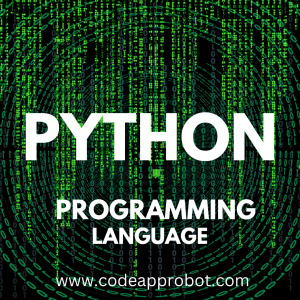Python for Data Science Machine Learning Artificial Intelligence Network System Administration Web Development

Python for Data Science Machine Learning Artificial Intelligence Network System Administration Web Development
Python for Data Science Machine Learning Artificial Intelligence Network System Administration Web Development
Python is a high-level, interpreted programming language used for a wide variety of applications, from web development and data science to machine learning and artificial intelligence. With its easy-to-read syntax and large community of users, Python has become one of the most popular programming languages in the world.
In this article, we will explore in detail the following topics related to Python:
- Data Science with Python
- Machine Learning with Python
- Artificial Intelligence with Python
- Network System Administration with Python
- Web Development with Python
Each of these topics can be studied separately and is ideal for those who want to specialize in that particular area of expertise.
- Data Science with Python:
Python is one of the most popular programming languages for data science. It is an essential tool for data scientists and analysts because of its powerful libraries and packages for data analysis and manipulation, including NumPy, Pandas, and Matplotlib. With Python, data scientists can perform data visualization, data analysis, and build predictive models.
The syllabus for data science with Python is as follows:
- Introduction to data science and Python
- Data Manipulation with NumPy and Pandas
- Data Visualization with Matplotlib
- Exploratory Data Analysis (EDA) with Python
- Supervised Learning with Scikit-Learn
- Unsupervised Learning with Scikit-Learn
- Deep Learning with TensorFlow and Keras
- Natural Language Processing with Python
- Machine Learning with Python:
Python is also widely used for machine learning applications. With its simple syntax and extensive libraries, it is an ideal choice for building machine learning models. Python provides popular machine learning libraries like Scikit-Learn, TensorFlow, Keras, and PyTorch.
The syllabus for machine learning with Python is as follows:
- Introduction to machine learning and Python
- Data Preprocessing with Python
- Regression and Classification with Scikit-Learn
- Clustering with Scikit-Learn
- Neural Networks with TensorFlow and Keras
- Convolutional Neural Networks (CNN) and Recurrent Neural Networks (RNN) with TensorFlow and Keras
- Support Vector Machines (SVM) with Scikit-Learn
- Natural Language Processing with Python
- Artificial Intelligence with Python:
Python is also used for artificial intelligence (AI) applications like computer vision, natural language processing, and speech recognition. Python provides many libraries and packages for AI development, such as TensorFlow, Keras, PyTorch, OpenCV, and NLTK.
The syllabus for artificial intelligence with Python is as follows:
- Introduction to artificial intelligence and Python
- Computer Vision with OpenCV
- Natural Language Processing (NLP) with NLTK
- Speech Recognition with Python
- Reinforcement Learning with Python
- Generative Adversarial Networks (GANs) with Python
- Convolutional Neural Networks (CNN) and Recurrent Neural Networks (RNN) with TensorFlow and Keras
- Network System Administration with Python:
Python is used for network system administration tasks like network automation, configuration management, and network monitoring. Python provides many libraries and packages for network programming and automation, such as Paramiko, Netmiko, and Napalm.
The syllabus for network system administration with Python is as follows:
- Introduction to network system administration and Python
- Network Automation with Python
- Configuration Management with Python
- Network Monitoring with Python
- Network Security with Python
- Paramiko and Netmiko for network automation
- Napalm for network automation and network configuration management
- Web Development with Python:
Python is also used for web development applications, from web design to back-end development. Python provides many web development frameworks such as Django, Flask, and Pyramid.
Python for Data Science Machine Learning Artificial Intelligence Network System Administration Web Development
The syllabus for web development with Python is as follows
Introduction to Web Development with Python
- Overview of web technologies and architecture
- Introduction to Python web frameworks (e.g. Django, Flask)
- Setting up a development environment
HTML and CSS Fundamentals
- Introduction to HTML tags and attributes
- Understanding CSS syntax and selectors
- Creating responsive layouts using CSS Grid and Flexbox
JavaScript and Front-End Development
- Introduction to JavaScript fundamentals and syntax
- Working with the Document Object Model (DOM)
- Handling events and user interactions
- Building interactive interfaces with jQuery
Python Web Frameworks
- Introduction to Django and Flask web frameworks
- Understanding views, models, and templates
- Creating web forms and handling user input
- Working with databases and the ORM
Building Web Applications
- Building a simple blog application with Django or Flask
- Adding authentication and user management features
- Integrating third-party APIs and services
- Deploying a web application to a hosting provider
Web Application Security
- Understanding common web vulnerabilities (e.g. XSS, CSRF)
- Securing web applications with authentication and authorization
- Best practices for secure coding and application deployment
Web Performance Optimization
- Understanding web performance metrics and tools
- Optimizing web application loading speed
- Caching and content delivery networks (CDNs)
Advanced Python Web Development Topics
- Using asynchronous programming with asyncio and websockets
- Building RESTful APIs with Flask-RESTful and Django Rest Framework
- Building real-time applications with WebSockets and Django Channels
Python for Data Science Machine Learning Artificial Intelligence Network System Administration Web Development
Python is a high-level, interpreted programming language that was first released in 1991. It is designed to be simple, easy to read, and easy to write. It is open source and has a large and active community of developers, which has contributed to its popularity.
Python is a versatile language that can be used for a variety of purposes, including web development, data analysis, machine learning, scientific computing, game development, and more. It is a popular choice for both beginners and experienced developers due to its ease of use and powerful features.
One of the key features of Python is its simplicity and readability. It uses an easy-to-understand syntax that makes it easy for developers to write and understand code. Python code is also highly maintainable, which means that it is easy to modify and update as needed.
Another important feature of Python is its large and active community of developers. This community has contributed to the development of many libraries and frameworks that make it easier to develop applications in Python. Some of the most popular Python libraries and frameworks include NumPy, Pandas, Matplotlib, Flask, Django, and Pygame.
Python also has a strong focus on data analysis and scientific computing. It provides a variety of tools and libraries that make it easy to work with data, including NumPy for numerical computing, Pandas for data manipulation, and Matplotlib for data visualization.
In addition, Python is a popular language for machine learning and artificial intelligence. It provides a range of libraries and frameworks, such as TensorFlow and Scikit-learn, that make it easy to build and train machine learning models.
Overall, Python is a powerful and versatile language that is well-suited for a wide range of applications. Its simplicity, readability, and strong community support make it an ideal choice for developers of all levels.
Python for Data Science Machine Learning Artificial Intelligence Network System Administration Web Development
frequently asked questions (FAQ) about Python:
Python is a high-level, interpreted programming language that is used for general-purpose programming. It was first released in 1991 by Guido van Rossum, and it is now one of the most popular programming languages in the world.
Python is a versatile language that can be used for a wide range of applications, including web development, scientific computing, data analysis, artificial intelligence, machine learning, automation, and more.
Python is a popular language for a number of reasons, including its simplicity, ease of use, flexibility, and wide range of libraries and frameworks available. It is also a great language for beginners, as it has a gentle learning curve and is easy to read and understand.
There are many popular libraries and frameworks in Python, including NumPy, pandas, TensorFlow, PyTorch, Django, Flask, and more. These libraries and frameworks are used for a wide range of applications, including data analysis, machine learning, web development, and more.
To get started with Python, you will need to download and install the Python interpreter on your computer. You can then use a text editor or an integrated development environment (IDE) to write and run Python code.
Yes, Python is a great language for beginners, as it has a simple syntax and is easy to read and understand. It is also widely used in the industry, which makes it a valuable skill to learn.
Python is often compared to other popular programming languages, such as Java, C++, and JavaScript. While each language has its own strengths and weaknesses, Python is often praised for its ease of use, flexibility, and versatility.
Yes, Python can be used for web development, and there are many popular web frameworks available in Python, such as Django and Flask.
Yes, Python is a popular language for machine learning and data analysis, and there are many libraries and frameworks available in Python for these purposes, such as NumPy, pandas, TensorFlow, and PyTorch.
Yes, Python is a popular language for scientific computing, and there are many libraries available in Python for this purpose, such as NumPy, SciPy, and Matplotlib.
